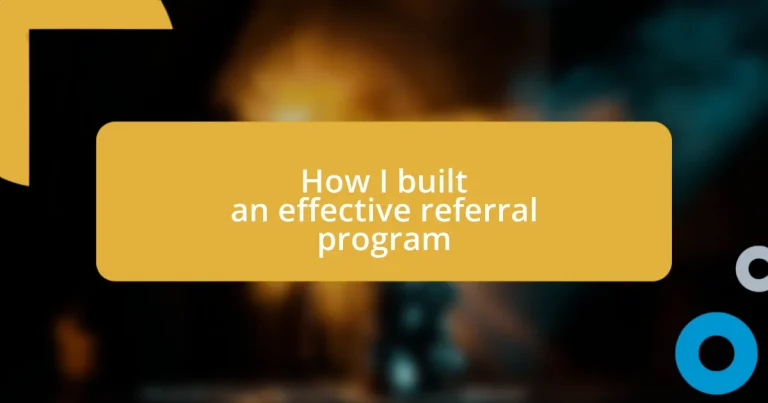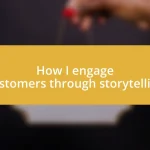Key takeaways:
- Referral programs build trust and foster customer loyalty by leveraging personal endorsements and offering appealing rewards.
- Understanding your target audience through demographics, psychographics, and behaviors is crucial for designing effective referral incentives.
- Success measurement should focus on the quality of referrals and customer lifetime value rather than just the quantity, alongside gathering feedback for continuous improvement.
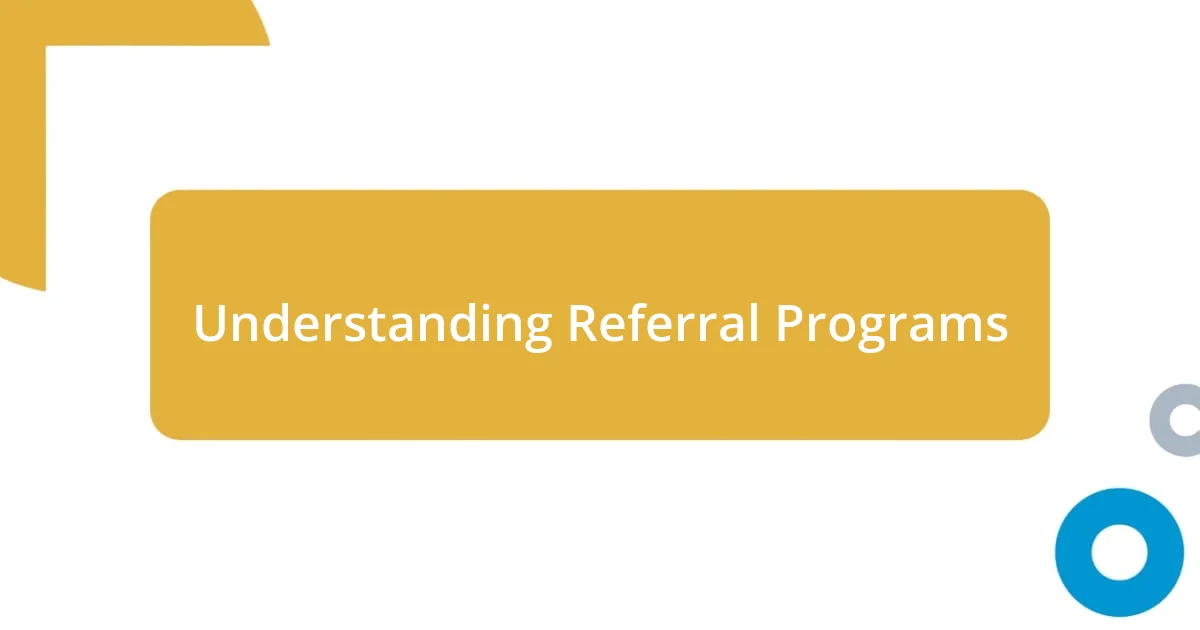
Understanding Referral Programs
Referral programs are fascinating mechanisms that tap into the power of word-of-mouth marketing. From my experience, when someone I trust recommends a product or service, I feel a sense of confidence in that choice. It’s like having a personal endorsement, and I often find myself wondering – why wouldn’t businesses want to harness that natural trust?
I’ve seen firsthand how referral programs can create a win-win situation for businesses and customers alike. In one instance, I participated in a program that not only rewarded me for bringing in new customers but also offered my friends a discount. That feeling of sharing something good with friends while earning a little something for myself was incredibly motivating. I’ve always thought, why wouldn’t more companies embrace this model?
Designing a successful referral program is about understanding what drives your audience. I once helped a small business design a program based on customer feedback, which guided us to create appealing rewards. This approach fostered a sense of community around the brand, making me realize just how essential it is to listen to customers when developing these initiatives. Isn’t it amazing how simple acts of kindness, like recommending a product, can lead to both business growth and customer loyalty?
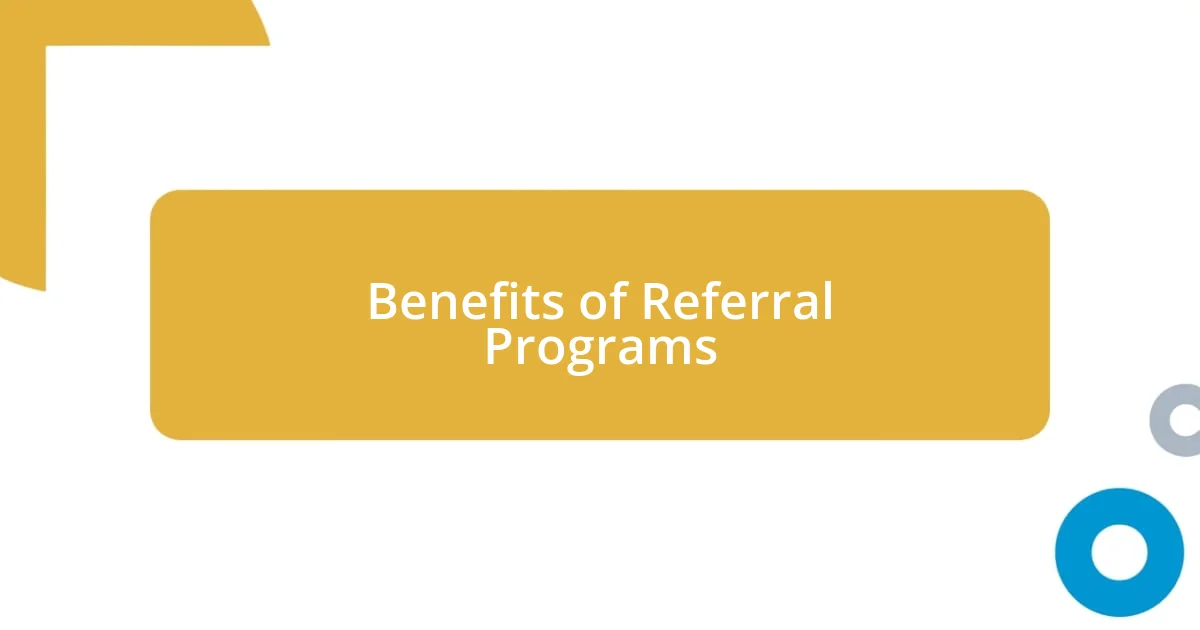
Benefits of Referral Programs
One of the most compelling benefits of referral programs is their ability to generate higher-quality leads. When a friend recommends a product, it’s usually because they’ve had a positive experience, which gives that referral a sense of reliability even before a potential customer engages with the brand. I recall a time when I decided to try a new software tool simply because a colleague couldn’t stop raving about it. That strong word-of-mouth was vastly more persuasive than any ad I had seen.
This brings me to another significant advantage: cost-effectiveness. Referral programs typically require less spend on marketing compared to traditional strategies. Consider these benefits:
- Increased Customer Trust: Referrals naturally carry more weight than ads or promotions.
- Lower Customer Acquisition Costs: Businesses can save big on marketing spends while still attracting quality leads.
- Enhanced Customer Loyalty: When customers feel valued through rewards, they tend to stick around.
- Improved Brand Awareness: As happy customers share their experiences, the brand’s visibility expands organically.
These advantages have consistently helped businesses thrive. I’ve observed this directly: when using referral programs, brands seem to find that sweet spot where marketing meets genuine connection.
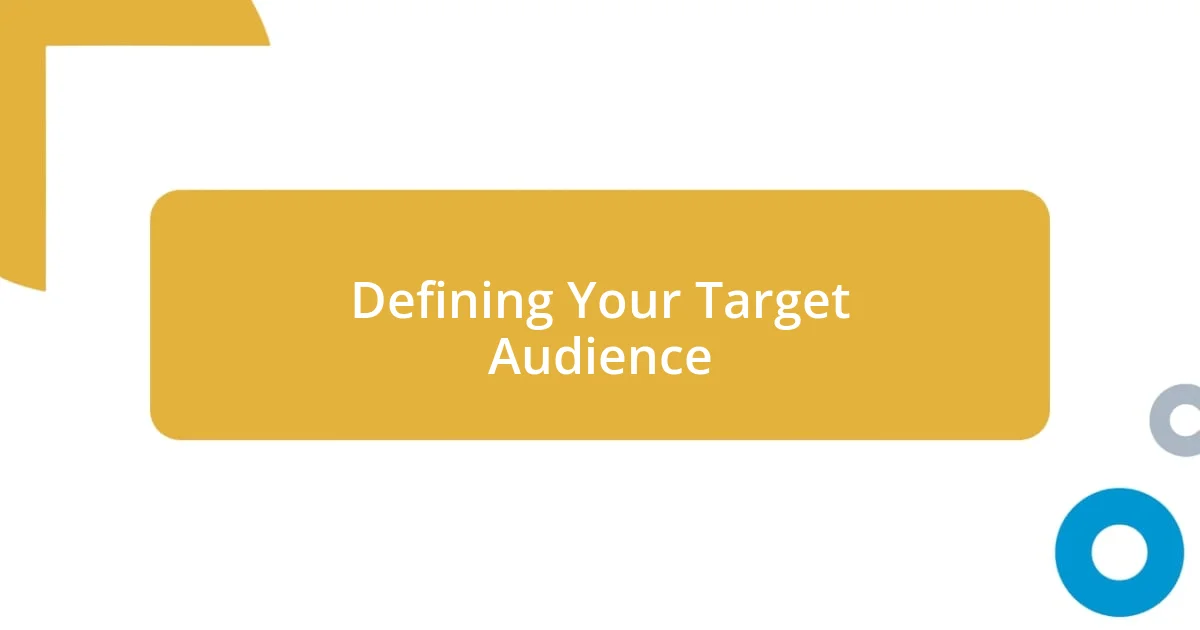
Defining Your Target Audience
Defining your target audience is crucial for creating an effective referral program. I remember when I first started looking into this; I had my assumptions about who would benefit from my program, but I realized I needed to dig deeper. It’s about more than demographics; understanding the motivations, preferences, and pain points of your audience can really enhance the connection. Taking time to research these aspects can transform a generic program into something that resonates personally with each customer.
I often reflect on a successful campaign I initiated. By segmenting my audience into specific personas based on their needs and preferences, I was able to tailor the referral incentives directly to them. For example, customers who valued sustainable practices responded positively to eco-friendly rewards. This insight led to a boost in participation, and I felt a deep sense of fulfillment knowing I had made the program more meaningful. Have you ever thought about how understanding your audience can pave the way for deeper relationships and better engagement?
Lastly, creating personas can be a game-changer. It helps focus your messaging and incentives on what truly matters to each audience segment. As I developed these personas, I found myself continually adjusting my approach based on feedback and interactions. I learned that the more aligned your referral program is with your audience’s expectations, the more likely it is to flourish. It’s an ongoing dialogue that I cherish—a chance to connect authentically.
| Aspect | Details |
|---|---|
| Demographics | Age, gender, location, etc. |
| Psychographics | Interests, values, lifestyle choices |
| Behaviors | Purchasing patterns, referral habits |
| Needs & Pain Points | What challenges can your program solve? |
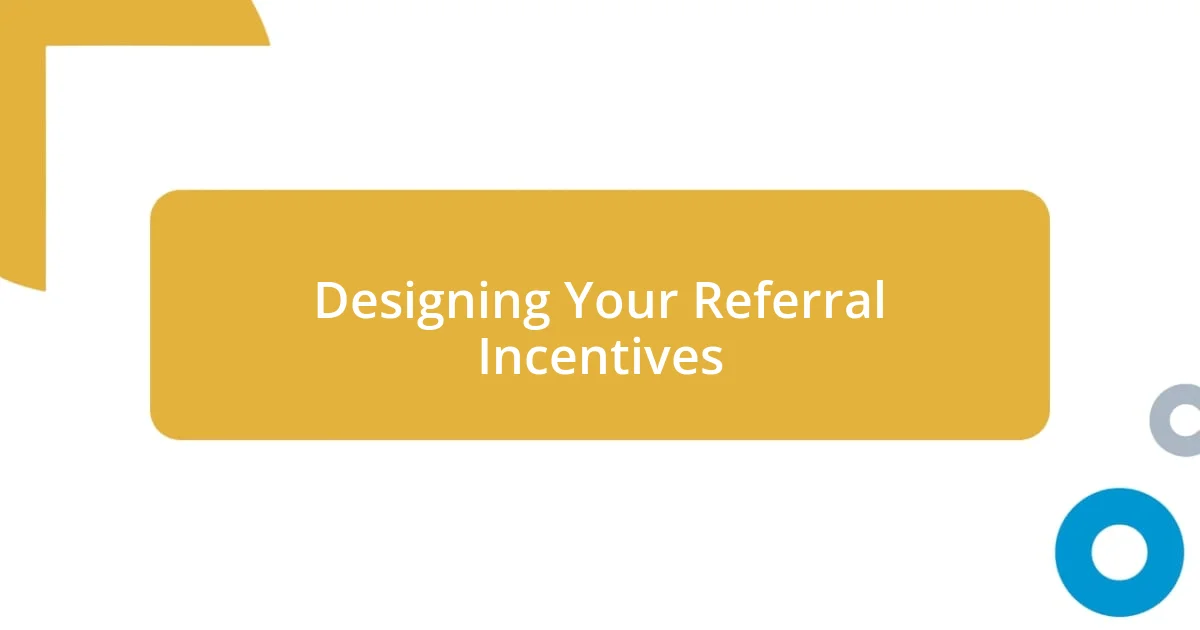
Designing Your Referral Incentives
When designing referral incentives, I find it essential to strike a balance between appealing and sustainable rewards. Early in my career, I tried offering extravagant prizes, thinking they would motivate people. But I quickly discovered that smaller, consistent incentives, like discounts or loyalty points, foster stronger connections. You want your referrers to feel valued but also to perceive the rewards as attainable. Have you ever felt disheartened when aiming for a prize that seemed out of reach? It’s a simple truth: achievable rewards can build lasting engagement.
Another vital aspect is ensuring the incentives are clearly communicated. I remember launching a referral program and assuming everyone would grasp its benefits right away. However, I was met with confusion instead. When I revamped my communication strategy—highlighting exactly what was in it for them—I noticed a significant uptick in participation. What do you think? Clear messaging can often be the difference between a thriving program and a forgotten one.
Lastly, keep in mind the emotional impact of your incentives. I once ran a campaign that included not just discounts but also a charitable donation for every successful referral. It felt rewarding to my customers and to me. People love being part of something bigger, and when they see that their referrals contribute to a good cause, it deepens their emotional investment in your brand. So, how can your incentives spark joy and a sense of purpose? It’s a question worth pondering.
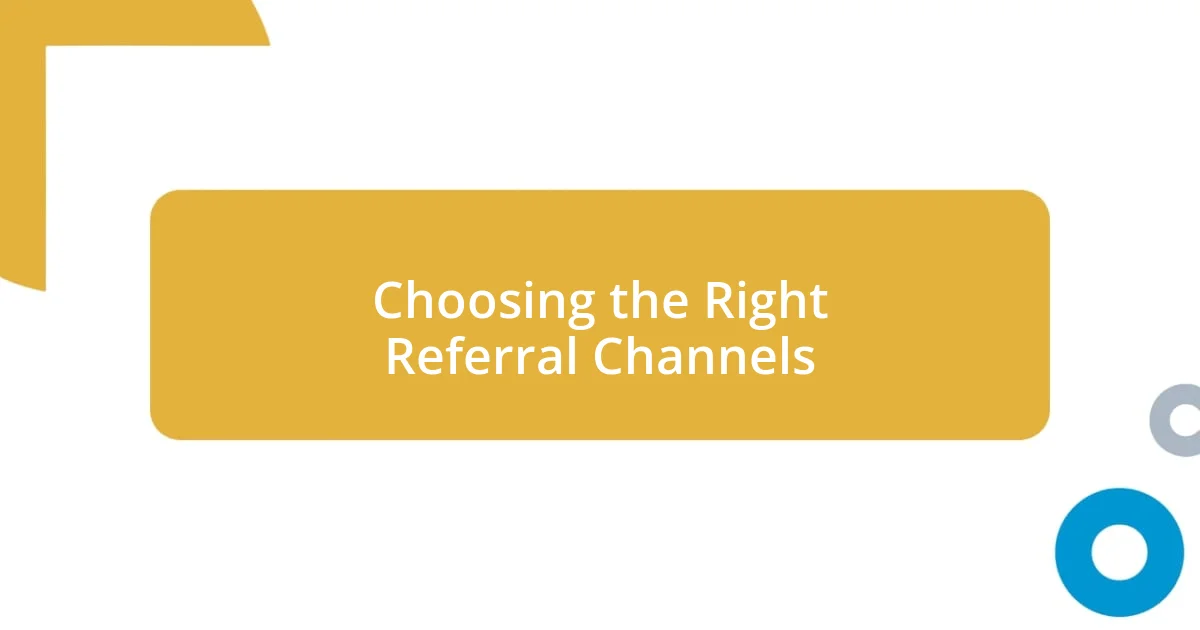
Choosing the Right Referral Channels
When it comes to choosing the right referral channels, I’ve discovered it’s not a one-size-fits-all situation. Initially, I thought social media would be my best platform, but I soon realized that my audience preferred email communication for sharing referrals. This discovery shifted my focus, and I started integrating email campaigns that encouraged sharing. It’s all about finding where your audience feels most comfortable connecting. Have you ever considered how different channels resonate with varying segments of your audience?
Another key factor in channel selection is understanding engagement levels. During one of my campaigns, I tracked which channels drove the most traffic and referrals. It turned out that a specific online forum related to my industry was a goldmine for qualified leads. I’d often overlook such spaces, assuming they might not have enough influence. But direct engagement with the community in these channels not only yielded referrals but also built trust. What channels have you previously underestimated?
Experimentation becomes a part of the journey. I recall launching my program across multiple channels simultaneously. While it felt like throwing spaghetti at the wall, I quickly learned that monitoring success rates clarified what worked best. One channel might yield a steady flow, while others barely made a ripple. Have you thought about the importance of continuously testing and refining your approach? It’s this kind of fine-tuning that can turn an average referral program into a thriving one.
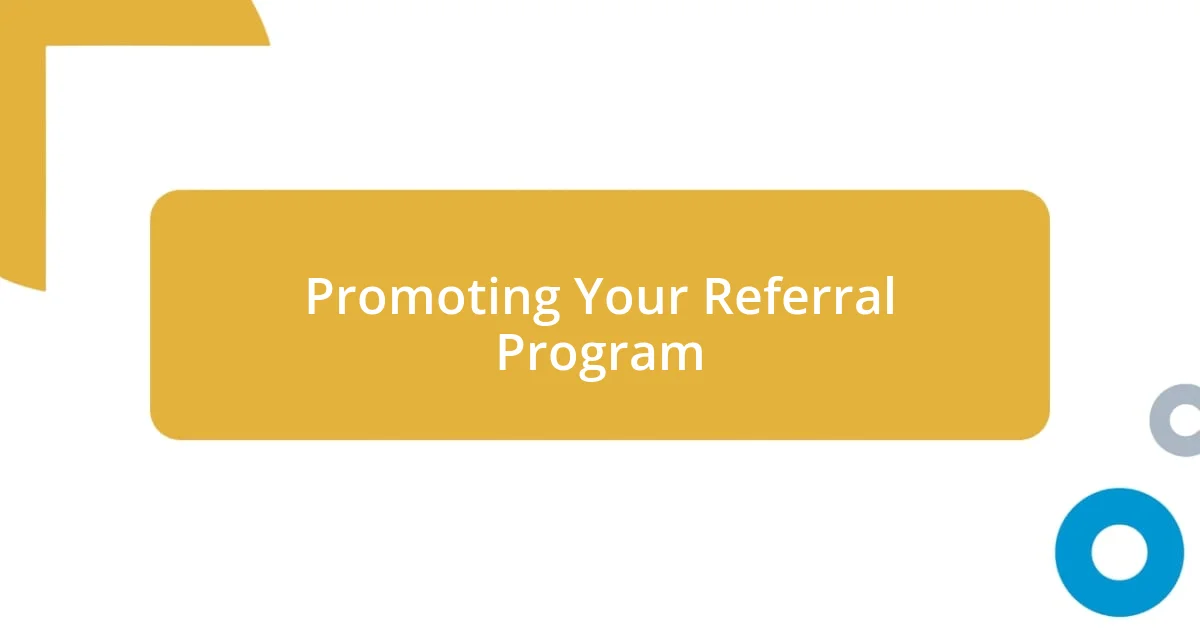
Promoting Your Referral Program
Promoting your referral program effectively hinges on leveraging multiple marketing channels to reach potential referrers. I remember one particular launch where I underestimated the power of in-person events. During a small networking gathering, I casually mentioned the program and the response was electric—people were excited to sign up right then and there. Have you ever experienced the thrill of seeing firsthand the enthusiasm of your audience? It’s moments like these that remind me of the importance of both online and offline promotion.
Social media can be a game-changer if used creatively. I discovered that visually engaging posts showcasing successful referrals created a buzz that organic reach simply couldn’t match. One time, I shared a customer testimonial video with a referral link attached, and within days, I saw a surge in sign-ups. It made me realize how storytelling—combined with a clear call to action—could transform passive viewers into active participants. What kinds of stories resonate with your audience?
Email marketing can’t be overlooked either. After a few attempts, I found that sending out personalized emails to my existing customers who had previously engaged with the brand encouraged them to refer friends. I often included reminders of how easy it was to share the program, and to my surprise, the conversion rate increased significantly. It’s fascinating how a simple nudge can ignite action. Are you tapping into those existing relationships effectively? Building on pre-existing trust can amplify your referral efforts in remarkable ways.
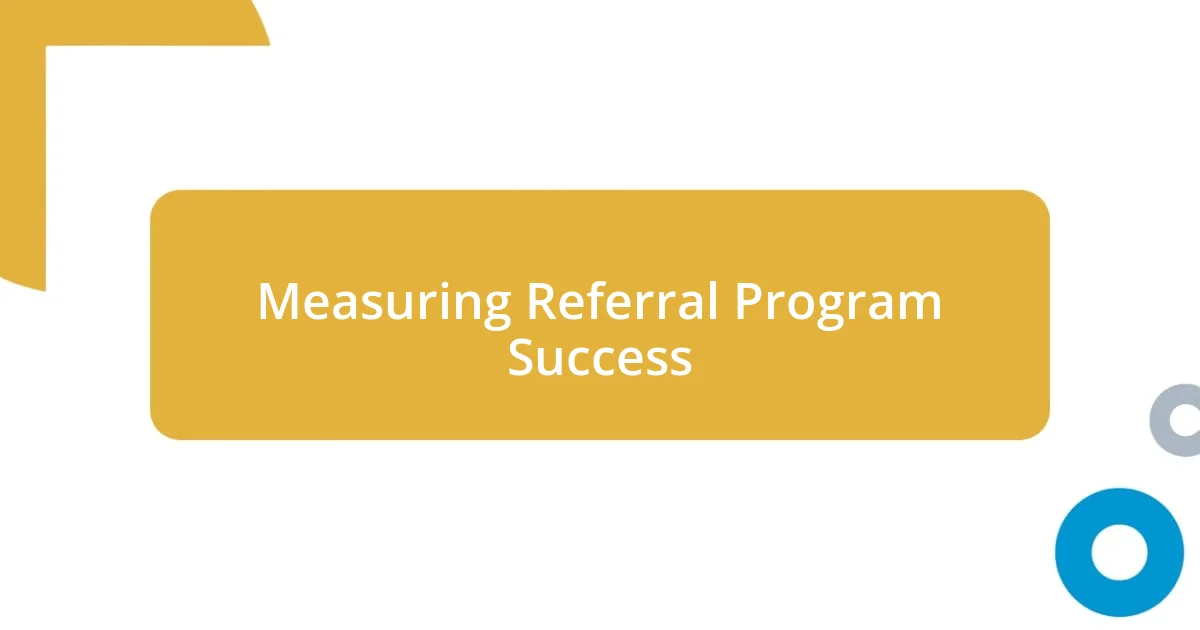
Measuring Referral Program Success
Measuring the success of my referral program was an enlightening journey. I quickly learned that it’s not just about the number of referrals generated but also about the quality of those referrals. For instance, I used to celebrate every new sign-up, but over time, I realized that tracking customer lifetime value (CLV) of referred customers provided a deeper understanding of the program’s effectiveness. Has anyone else felt that initial excitement fade when they realized quantity doesn’t always equal quality?
Another important metric I examined was the referral conversion rate. Initially, I found this number fluctuated wildly, leaving me puzzled. After diving deeper, I identified specific points in the customer journey where referrals were dropping off. By refining those steps, the conversion rate skyrocketed. This taught me that understanding where your audience gets lost is crucial. Have you ever pinpointed a moment in your process where potential leads slip through the cracks?
Lastly, I started gathering feedback directly from my referrers. I once launched a quick survey to understand their motivations and the kind of incentives that excited them. The insights I gained were invaluable. I discovered that simple gestures of appreciation, like handwritten thank-you notes, made a lasting impression. Analyzing referral patterns and social sentiment really allowed me to refine my program. What methods have you found effective in tapping into your audience’s feelings and motivations?












